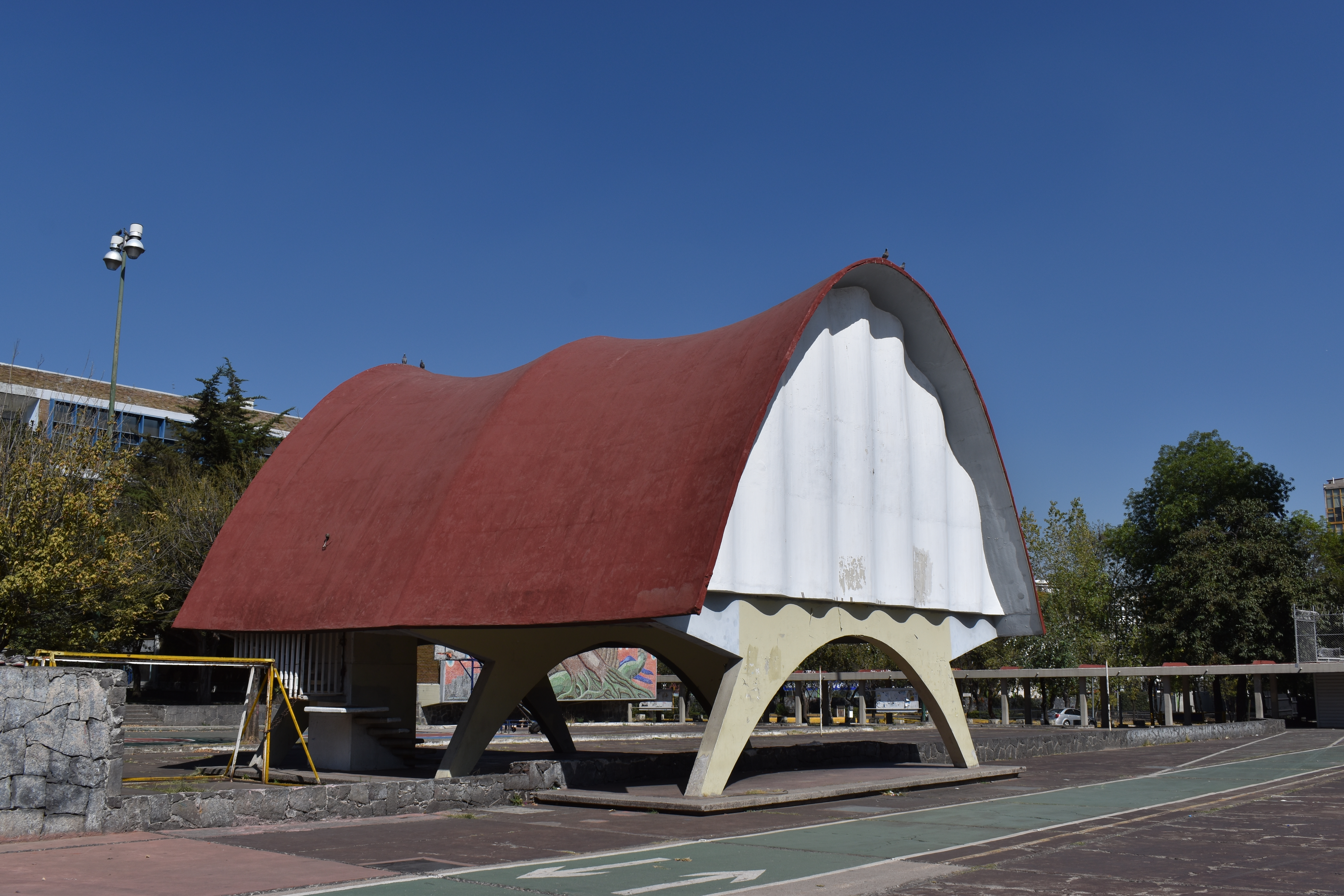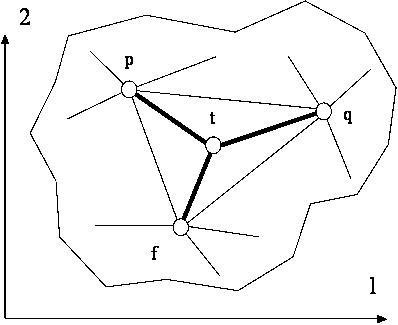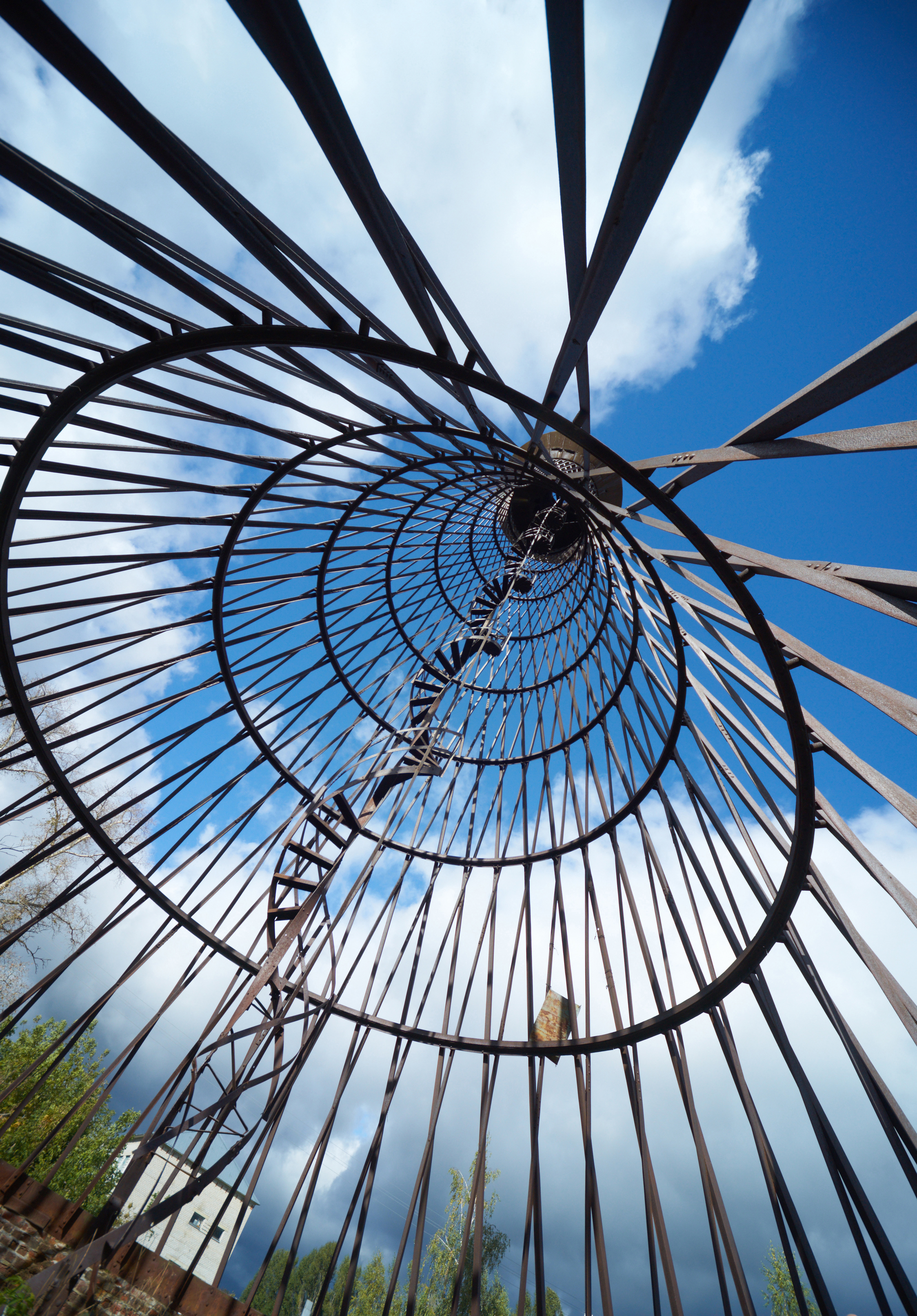|
Shell (structure)
A shell is a type of structural element which is characterized by its geometry, being a three-dimensional solid whose thickness is very small when compared with other dimensions, and in structural terms, by the stress resultants calculated in the middle plane displaying components which are both coplanar and normal to the surface. Essentially, a shell can be derived from a plate (structure), plate by two means: by initially forming the middle surface as a singly or doubly curved surface, and by applying loads which are coplanar to a plate's plane (geometry), plane which generate significant stresses. Thin-shell structures (also called plate and shell structures) are lightweight constructions using List of structural elements, shell elements. These elements, typically curved, are assembled to make large structures. Typical applications include aircraft fuselages, boat hulls, and the roofs of large buildings. Definition A thin shell is defined as a shell with a thickness which is ... [...More Info...] [...Related Items...] OR: [Wikipedia] [Google] [Baidu] |
Hyperboloid Structure
Hyperboloid structures are architectural structures designed using a hyperboloid in one sheet. Often these are tall structures, such as towers, where the hyperboloid geometry's structural strength is used to support an object high above the ground. Hyperboloid geometry is often used for decorative effect as well as structural economy. The first hyperboloid structures were built by Russian engineer Vladimir Shukhov (1853–1939), including the Shukhov Tower in Polibino, Dankovsky District, Lipetsk Oblast, Russia. Properties Hyperbolic structures have a negative Gaussian curvature, meaning they curve inward rather than curving outward or being straight. As doubly ruled surfaces, they can be made with a lattice of straight beams, hence are easier to build than curved surfaces that do not have a ruling and must instead be built with curved beams. Hyperboloid structures are superior in stability against outside forces compared with "straight" buildings, but have shapes often cre ... [...More Info...] [...Related Items...] OR: [Wikipedia] [Google] [Baidu] |
Eugène Freyssinet
Eugène Freyssinet () (13 July 1879 – 8 June 1962) was a French structural and civil engineer. He was the major pioneer of prestressed concrete. Biography Freyssinet was born in at Objat, Corrèze, France. He worked in the '' École Nationale des Ponts et Chaussées'' in Paris, France where he designed several bridges until the First World War intervened. His tutors included Charles Rabut. He served in the French Army from 1904 to 1907 and again from 1914 to 1918 as a road engineer. His most significant early bridge was the three span Pont le Veurdre near Vichy, built in 1911. At the time, the 72.5 metre (238 ft) spans were the longest so far constructed in France although Grafton Bridge a 97.6 metre reinforced concrete bridge had been opened in April 1910 and the Rocky River Bridge in Cleveland Ohio, an 85.34 metre unreinforced bridge had been opened in October 1910. Freyssinet's proposal was for three reinforced concrete truss spans, and was significantly less expe ... [...More Info...] [...Related Items...] OR: [Wikipedia] [Google] [Baidu] |
Wilhelm Flügge
Gottfried Wilhelm Flügge (March 18, 1904 – March 19, 1990) was a German engineer, and Professor of Applied Mechanics at Stanford University.J.J. O'Connor and E.F. Robertson.Gottfried Wilhelm Flügge" at ''history.mcs.st-and.ac.uk.'' School of Mathematics and Statistics University of St Andrews, 2015. Accessed 2017-09-20.James Gere, George Herrmann, Charles R. Steele." at website Historical Society, Stanford University, 2004. He is known as recipient of the 1970 Theodore von Karman Medal in Engineering Mechanics, and the 1970 Worcester Reed Warner Medal.''Engineers of Distinction,'' Volume 2. 1973, p. 101 In 1934 Flügge published his most noted work ''Statik und Dynamik der Schalen'' in German, in 1960 translated it into English, entitled ''Stresses in shells.'' In those days this work evolved into the international standard work on shell theory. As Gere et al. (2004) put it, that work "served as the handbook for designers of concrete roofs, pressure vessels for storage and po ... [...More Info...] [...Related Items...] OR: [Wikipedia] [Google] [Baidu] |
Dyckerhoff & Widmann
Dyckerhoff & Widmann AG (Dywidag) was a construction company based in Munich, Germany (formerly based in Karlsruhe, Wiesbaden and Berlin, Germany). History The company was founded under the name ''Lang & Co.'' in 1865 by the German cement pioneer Wilhelm Gustav Dyckerhoff (1805–1894) in Karlsruhe, Germany. In the early years the company was mainly engaged in the production of concrete components. In 1866 Dyckerhoff's son Eugen Dyckerhoff (1844–1924) entered the company. He and his father-in-law Gottlieb Widmann changed the company's name to ''Dyckerhoff & Widmann'' and made it one of the leading companies for concrete construction in Germany. Starting in the field of construction engineering in the 1880s, the company soon got contracts for impressive buildings like the Centennial Hall (''Jahrhunderthalle'') in Wroclaw. The company introduced many innovations in the field of concrete construction. Eugen Dyckerhoff developed the ''Stampfbeton'', a compressed concrete that be ... [...More Info...] [...Related Items...] OR: [Wikipedia] [Google] [Baidu] |
Félix Candela
Félix Candela Outeriño (; January 27, 1910 – December 7, 1997) was a Spanish and Mexican architect who was born in Madrid and at the age of 26, emigrated to Mexico, acquiring double nationality. He is known for his significant role in the development of Mexican architecture and structural engineering. Candela's major contribution to architecture was the development of thin shells made out of reinforced concrete, popularly known as ''cascarones''. He was Santiago Calatrava's icon who has had a great influence on his works. Early life Felix Candela was born in Madrid, Spain in 1910. In 1927 Candela enrolled in La Escuela Superior de Arquitectura (Madrid Superior Technical School of Architecture), graduating in 1935; at which time Candela traveled to Germany to further study architecture. Early after he started classes, he developed a very keen sense of geometry and started teaching other students in private lessons. In his junior year, his visual intelligence an ... [...More Info...] [...Related Items...] OR: [Wikipedia] [Google] [Baidu] |
List Of Thin Shell Structures
Thin-shell structures are lightweight constructions using shell elements. Notable projects Asia/Pacific * Nagoya Dome, Nagoya, Japan * Parish of the Holy Sacrifice at the University of the Philippines Diliman, Quezon City, Philippines * Putrajaya Convention Centre, Putrajaya, Malaysia * Sydney Opera House, Sydney, Australia * Tokyo Dome, Tokyo, Japan * Tower Infinity, Seoul, South Korea Europe * Adziogol Lighthouse, Kherson Oblast, Ukraine * Aquatoll, Neckarsulm, Germany * Berlin Main Station, Berlin, Germany * Dortmund Opera House, Dortmund, Germany * Dos Hermanas Velodrome, Dos Hermanas, Spain * Eden Project, Cornwall, England * Europe 1 Transmitter Building, Felsberg-Berus, Germany * Haus der Kulturen der Welt, Berlin, Germany * Imperial War Museum, Duxford, England * Parabolic steel-and-glass roof of the Kiyevsky railway station, Moscow, Russia * Korkeasaari Lookout Tower, Helsinki, Finland * L'Oceanogràfic at the City of Arts and Sciences, Valencia, Spain * Lo ... [...More Info...] [...Related Items...] OR: [Wikipedia] [Google] [Baidu] |
Stretched Grid Method
The stretched grid method (SGM) is a numerical technique for finding approximate solutions of various mathematical and engineering problems that can be related to an elastic grid behavior. In particular, meteorologists use the stretched grid method for weather prediction and engineers use the stretched grid method to design tents and other tensile structures. FEM and BEM mesh refinement In recent decades the finite element and boundary element methods (FEM and BEM) have become a mainstay for industrial engineering design and analysis. Increasingly larger and more complex designs are being simulated using the FEM or BEM. However, some problems of FEM and BEM engineering analysis are still on the cutting edge. The first problem is a reliability of engineering analysis that strongly depends upon the quality of initial data generated at the pre-processing stage. It is known that automatic element mesh generation techniques at this stage have become commonly used tools for the anal ... [...More Info...] [...Related Items...] OR: [Wikipedia] [Google] [Baidu] |
Diagrid
A diagrid (a portmanteau of diagonal grid) is a framework of diagonally intersecting metal, concrete, or wooden beams that is used in the construction of buildings and roofs. It requires less structural steel than a conventional steel frame. Hearst Tower in New York City, designed by Norman Foster, uses 21 percent less steel than a standard design. The diagrid obviates the need for columns and can be used to make large column-free expanses of roofing. Another iconic building designed by Foster, 30 St Mary Axe, in London, UK, known as "The Gherkin", also uses the diagrid system. British architect Ian Ritchie wrote in 2012: Buildings utilizing diagrid * Shukhov Tower in Polibino, Polibino, Russia (1896) * Shukhov Rotunda at the All-Russia exhibition, Nizhny Novgorod, Russia (1896) * Shukhov Tower, Moscow, Russia * Hearst Tower, New York, USA * 30 St Mary Axe, London, England * 1 The Avenue, Manchester, England * CCTV Headquarters, Beijing, China * The Bow, Calga ... [...More Info...] [...Related Items...] OR: [Wikipedia] [Google] [Baidu] |
Monocoque
Monocoque ( ), also called structural skin, is a structural system in which loads are supported by an object's external skin, in a manner similar to an egg shell. The word ''monocoque'' is a French term for "single shell". First used for boats, a true monocoque carries both tensile and compressive forces within the skin and can be recognised by the absence of a load-carrying internal frame. Few metal aircraft other than those with milled skins can strictly be regarded as pure monocoques, as they use a metal shell or sheeting reinforced with frames riveted to the skin, but most wooden aircraft are described as monocoques, even though they also incorporate frames. By contrast, a semi-monocoque is a hybrid combining a tensile stressed skin and a compressive structure made up of longerons and ribs or frames. Other semi-monocoques, not to be confused with true monocoques, include vehicle unibodies, which tend to be composites, and inflatable shells or balloon tanks, both of whic ... [...More Info...] [...Related Items...] OR: [Wikipedia] [Google] [Baidu] |
Pneumatic Structure
An air-supported (or air-inflated) structure is any building that derives its structural integrity from the use of internal pressurized air to inflate a pliable material (i.e. structural fabric) envelope, so that air is the main support of the structure, and where access is via airlocks. The first air-supported structure built in history was the radome manufactured at the Cornell Aeronautical Laboratory in 1948 by Walter Bird. The concept was implemented on a large scale by David H. Geiger with the United States pavilion at Expo '70 in Osaka, Japan in 1970. It is usually dome-shaped, since this shape creates the greatest volume for the least amount of material. To maintain structural integrity, the structure must be pressurized such that the internal pressure equals or exceeds any external pressure being applied to the structure (i.e. wind pressure). The structure does not have to be airtight to retain structural integrity—as long as the pressurization system that supplies ... [...More Info...] [...Related Items...] OR: [Wikipedia] [Google] [Baidu] |
Cable Dome
Cable may refer to: Mechanical * Nautical cable, an assembly of three or more ropes woven against the weave of the ropes, rendering it virtually waterproof * Wire rope, a type of rope that consists of several strands of metal wire laid into a helix ** Arresting cable, part of a system used to rapidly decelerate an aircraft as it lands ** Bowden cable, a mechanical cable for transmitting forces * Rope generally, especially a thick, heavy ("cable laid") variety Transmission * Electrical cable, an assembly of one or more wires which may be insulated, used for transmission of electrical power or signals ** Coaxial cable, an electrical cable comprising an inner conductor surrounded by a flexible, tubular insulating layer, coated or surrounded by a tubular conducting shield ** Power cable, a cable used to transmit electrical power ** Submarine communications cable, a cable laid on the sea bed to carry telecommunication signals between land-based stations * Fiber-optic cable, a cable ... [...More Info...] [...Related Items...] OR: [Wikipedia] [Google] [Baidu] |




